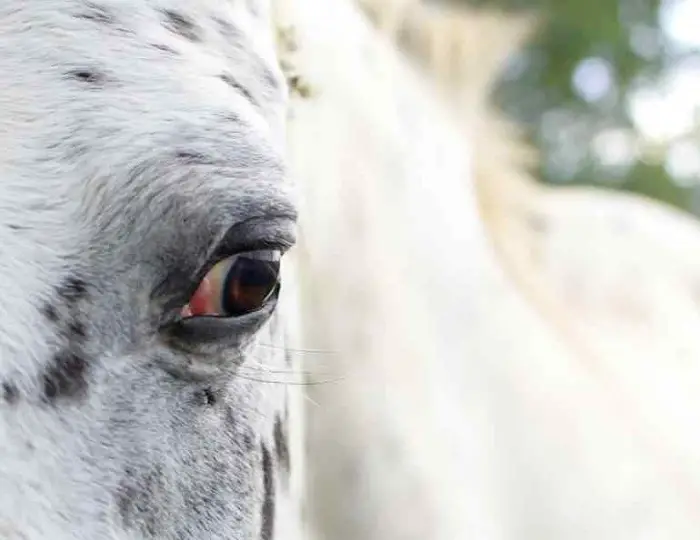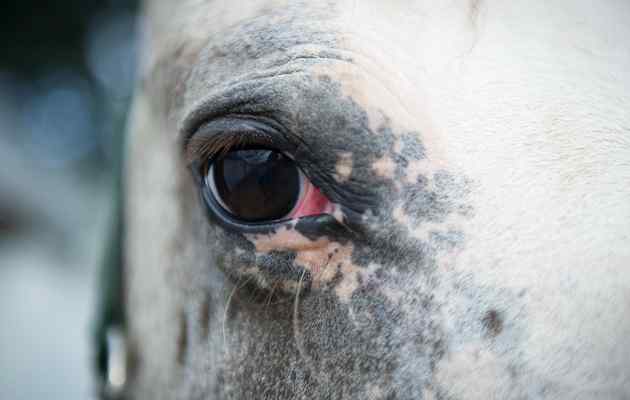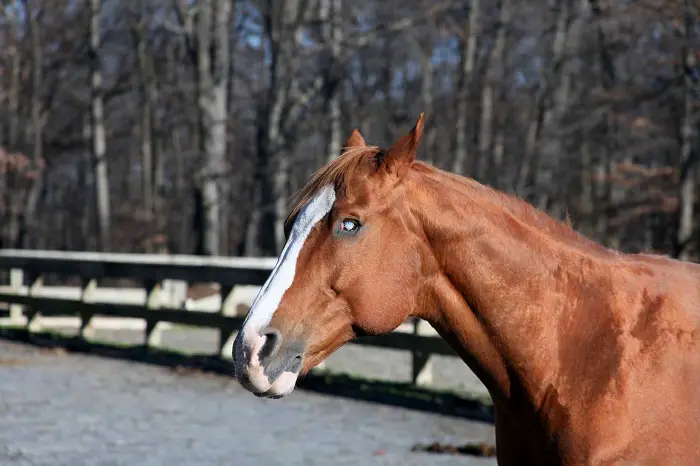Moon blindness in Horses or Equine Recurrent Uveitis (ERU) is the most common cause of blindness in horses worldwide. The disease affects 5 to 25% of horses, and more than 56% become blind. A study showed that more than 60 percent of affected horses could not return to normal.
Moon Blindness is characterized by the repeated inflammation of the uveal tract of the eye that affects one or both eyes. The sub-clinical ERU is manifested by insidious inflammation of the uveal tract. The consequences of ERU are cataracts, glaucoma, and blindness in horses.
The uveal tract is the vascular part of the eye that is essential for the proper nourishment and functioning of the eyes. This disease is one of the first to be documented in horses by veterinarians. The disease was recognized during the 1600s and named as it progressed with the moon’s phases.
What is moon blindness in horses?
Equine recurrent uveitis is the inflammation of the uveal tract of one or both eyes that leads to blindness. Moon blindness in horses is an autoimmune condition and the most common cause of equine blindness.
Causes of Equine Recurrent Uveitis
The exact causes of moon blindness are unknown, but they must be investigated. There are three major causes of recurrent uveitis in horses: ocular, systemic, and non-immune mediated. The ocular causes of moon blindness are:
- Trauma to eyes.
- Corneal ulcers.
- Lens-induced uveitis.
- Immune-mediated uveitis.
Bacteria, viruses, protozoa, or fungi may cause the systemic causes of moon blindness.
- Leptospira canicula, Brucella spp, and Streptococcus spp.
- Equine flu, Equine viral arteritis virus, and Equine Parainfluenza virus-3.
- Chlamydia, and Mycoplasma.
- Oncocerca cervicalis, Microfilarai, Strongylus spp.
- Protozoa- Toxoplasma gondi.
- Tooth and hoof abscesses.
- Vitamin deficiencies.
- Physical injury.
- Certain anthelmintics (deworming medications).
Immune-mediated uveitis is associated with intermittent inflammation of the uveal tract.
Horse Breeds Prone to ERU
The following horse breeds are more prone to moon blindness:
- Appaloosa.
- Thoroughbred.
- American Quarter Horse.
- Hanoverian.
- German Wormblood Horse.
- American Paint Horse.
Clinical Signs of Moon Blindness in Horse
Equine recurrent uveitis may be seen in one or both eyes, and the clinical signs are more severe in one eye than in the other. The most common clinical manifestations are:
- Sensitive to lights.
- The horse will hold their eyelids half open or squint.
- Teary or watery eyes.
- Swollen eyelids.
- Excessive blinking.
- Constricted pupils.
- Spasm of the eyelid muscles.
- Cloudy eyes.
The disease is classified into three definitive syndromes:
1. Classical Moon Blindness.
This is the most common and is characterized by apparently painful and active eye inflammation. The condition is separated by periods of no or mild inflammation. There needs to be more vision in some aspects. The horse breeds that are mostly affected are Icelandic horses and warm-blood horses.
2. Insidious Moon Blindness
Horses with insidious moon blindness are characterized by persistent and low-grade inflammation of the eye. The condition is often not so painful but leads to degeneration of ocular structures, destruction of eye tissues, and loss of vision. This form of ERU is commonly seen in Draft horses and Appaloosa.
3. Posterior Moon Blindness
This is characterized by inflammation of posterior structures of the eye, like vitreous humor, choroid, and retina. Retinal degeneration is frequent in posterior moon blindness, seen in Draft and Warmblood horse breeds.
Diagnosis of Equine Recurrent Uveitis
The diagnostic protocols for Moon Blindness in equines are as follows:
- History of documented recurrent inflammation of one or both eyes.
- Clinical signs.
- Examination of eyes.
- Examine the eyeball’s anterior and posterior parts to distinguish it from other ocular diseases.
- Fluorescent stain to assess the health of the cornea.
- ELISA to identify the Leptospira-specific antibody.
- Complete Blood Count (CBC).
Treatment of Moon Blindness in Horses
The primary treatment for ERU is tropical and systemic anti-inflammatory drugs. Some veterinarians suggest antibiotics to treat moon blindness.
- Tropical corticosteroids like prednisolone and dexamethasone.
- Non-steroidal Anti-inflammatory drugs like diclofenac, ibuprofen, flurbiprofen, bromfenac, etc.
- Mydriatics drugs like atropine.
- Systemic corticosteroids like methylprednisolone, gentamycin, and triamcinolone.
- Systemic NSAIDs like flunixin meglumine and phenylbutazone.
- In the United States of America, Cyclosporin implants contain anti-inflammatory and corticosteroid drugs inside the affected eye that release the medication. This reduces oral and systemic medications.
Prevention of Equine Recurrent Uveitis
The preventive measures you can follow are:
- You must do an LP gene test before purchasing Appaloosa and Geran Warmblood Horse.
- Deworming of horses with appropriate anthelmintics prescribed by registered veterinarians.
- Take adequate care while finding any hoof abscess.
- Maintain a good plan of nutrition.
- Fly control in the stable and horse pasture.
- If you notice any inflammation in the eye, immediately inform your vet.
Prognosis of Equine Moon Blindness
The prognosis is favorable if the disease is diagnosed early and treatment is started. More than 60% of affected horses never come back to normal. In a study, more than 56 percent of horses become entirely blind. The consequence of ERU is cataracts and glaucoma.
Takeaway Points on Moon Blindness in Horses
Equine recurrent uveitis is among many horse breeds’ most common eye diseases. The disease is severe because the affected horse never becomes routine life. It would be best if you took the necessary care and preventive measures.
Thank you very much for reading. You can visit my website to learn more about horses. You can share your views and feelings with us.



